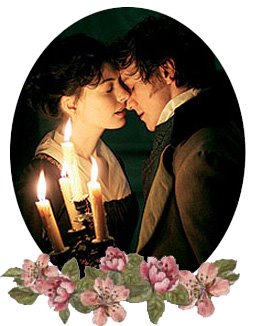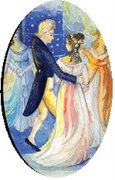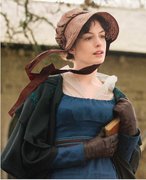Mariana's Analysis
Hello All,
I have not written a post for sometime but I wanted to share with you some of the wonderful
work that our dear friend Mariana has provided for us to read and learn from.Mariana has written her own interpretation of the similarities between the relationships of Tom Lefroy and Jane Austen and Charles Bingley and Jane Bennet (Pride and Prejudice). I am going to summarise her findings below. Both Tom Lefroy and Mr Bingley arrive into the company of their prospective partners around the period of Michaelmas (November 2nd-25th). Tom left his law studies in London at the end of Michaelmas term to reach Hampshire before Christmas. Mr Bingley moved in “before the michaelmas, and some of his servants are to be in the house by the end of next week.”Jane Austen and Tom Lefroy were the same age (Jane’s birthday 16/12 and Tom’s 08/01); they were both celebrating their 20th Birthdays when they met. Mr Bingley and Jane Bennet were also the same age; they were both nearly 23. A quote from Pride and Prejudice indicates this: “will be quite an old maid soon, I declare. She is almost three and twenty.”
Both Tom Lefroy and Mr Bingley arrive into the company of their prospective partners around the period of Michaelmas (November 2nd-25th). Tom left his law studies in London at the end of Michaelmas term to reach Hampshire before Christmas. Mr Bingley moved in “before the michaelmas, and some of his servants are to be in the house by the end of next week.”Jane Austen and Tom Lefroy were the same age (Jane’s birthday 16/12 and Tom’s 08/01); they were both celebrating their 20th Birthdays when they met. Mr Bingley and Jane Bennet were also the same age; they were both nearly 23. A quote from Pride and Prejudice indicates this: “will be quite an old maid soon, I declare. She is almost three and twenty.”
Tom Lefroy had 5 sisters; he was the first son to Colonel Anthony Lefroy and Anne Gardiner of Limerick. The Bennet’s in Pride and Prejudice have 5 daughters and Mrs Bennet’s maiden name was ‘Gardiner’; she even had a sister-in-law named Anne Gardiner! There is also a reference that Mr Bingley was expected to bring “from London his five sisters.”
Tom Lefroy and Jane Austen met firstly at one of the four balls that were held during the holiday season of 1795/6. Mr Bingley and Jane Bennet attended a ball in the village of Meryton- from the second chapter of the novel, it is highlighted how little time the couple spent together; probably around the same amount of time as Tom and Jane did. (Reference on blog) Both couples were attracted to each other, most likely from the first ball. Cassandra scolded Jane before the 3rd ball, at Manydown, so they were already close; “You scold me so much in the nice long letter which I have this moment received from you, that I am almost afraid to tell you how my Irish friend and I behaved.” In Pride and Prejudice, Elizabeth who knew Jane’s disposition very well was pleased to see her falling in love: “It was generally evident whenever they met, that he did admire her; and to her it was equally evident that Jane was yielding to the preference which she had begun to entertain for him from the first, and was in a way to be very much in love;”
The last ball that both of our couples danced at seemed uncertain and long expected. In the case of Tom and Jane, this ball was at Ashe Rectory and in a letter to Cassandra, Jane states “I can expose myself however, only once more, because he leaves the country soon after next Friday, on which day we are to have a dance at Ashe after all.” For Mr Bingley and Jane, the dance at Netherfield was also planned; “Mr. Bingley and his sisters came to give their personal invitation for the long expected ball at  Netherfield, which was fixed for the following Tuesday.” Jane danced and talked with Tom mainly at these balls. It appears that the only time she saw Tom at Steventon was on the very same day as the letter written to her sister Cassandra; Saturday, January 9: “After I had written the above, we received a visit from Mr. Tom Lefroy and his cousin George.” Although this kind of visit was typical; the gentleman calling on the lady he had danced with the previous evening, it is clear that they danced at two other balls before and Tom did not visit Jane at Steventon. It is more likely that Tom was actually accompanying his cousin, George Lefroy, to bring the invitation for the Ashe ball. To note, in Pride and Prejudice, Jane also did not write about a visit the day after the Meryton ball. Instead she described the visit before the Netherfield ball when Mr. Bingley and his sisters brought the invitation.
Netherfield, which was fixed for the following Tuesday.” Jane danced and talked with Tom mainly at these balls. It appears that the only time she saw Tom at Steventon was on the very same day as the letter written to her sister Cassandra; Saturday, January 9: “After I had written the above, we received a visit from Mr. Tom Lefroy and his cousin George.” Although this kind of visit was typical; the gentleman calling on the lady he had danced with the previous evening, it is clear that they danced at two other balls before and Tom did not visit Jane at Steventon. It is more likely that Tom was actually accompanying his cousin, George Lefroy, to bring the invitation for the Ashe ball. To note, in Pride and Prejudice, Jane also did not write about a visit the day after the Meryton ball. Instead she described the visit before the Netherfield ball when Mr. Bingley and his sisters brought the invitation.
Jane Austen was described by her family as being "reserved with strangers but open and kindly to those with whom she felt close and comfortable”. Her sister Cassandra Elizabeth was her only sister and closest confidante. In Pride and Prejudice, Jane also shared her feelings with her sister Elizabeth. Although five sisters were very close in age, the eldest two, Jane (22) and Elizabeth (20), had a stronger bond.It is quite probable that the same conversation took place
was described by her family as being "reserved with strangers but open and kindly to those with whom she felt close and comfortable”. Her sister Cassandra Elizabeth was her only sister and closest confidante. In Pride and Prejudice, Jane also shared her feelings with her sister Elizabeth. Although five sisters were very close in age, the eldest two, Jane (22) and Elizabeth (20), had a stronger bond.It is quite probable that the same conversation took place between the two sets of sisters; Jane and Cassandra and Jane and Elizabeth. What did Jane say to her sister Cassandra when she returned to Steventon? Months had passed without a word from him. In Pride and Prejudice “She could think of nothing else, and yet whether Bingley's regard had really died away, or were suppressed by his friends' interference; whether he had been aware of Jane's attachment, or whether it had escaped his observation; whichever were the case, though her opinion of him must be materially affected by the difference, her sister's situation remained the same, her peace equally wounded.”
between the two sets of sisters; Jane and Cassandra and Jane and Elizabeth. What did Jane say to her sister Cassandra when she returned to Steventon? Months had passed without a word from him. In Pride and Prejudice “She could think of nothing else, and yet whether Bingley's regard had really died away, or were suppressed by his friends' interference; whether he had been aware of Jane's attachment, or whether it had escaped his observation; whichever were the case, though her opinion of him must be materially affected by the difference, her sister's situation remained the same, her peace equally wounded.”
In August 1796, Jane wrote to Cassandra only few lines from Cork Street, London, where she stopped for a night on her way to Rowling, Kent. Jane started her short letter from Cork Street, London with “H ere I am once more” and continued “We are to be at Astley's to-night, which I am glad of.” In Pride and Prejudice, “Jane had already written a few lines to her sister to announce their safe arrival in London; and when she wrote again, Elizabeth hoped it would be in her power to say something of the Bingleys.” In Jane’s first letter that we have record of from Kent, Jane apologised to Cassandra for the length of her previous letter and promised to start writing some elaborate details: “I am sorry that you found such a conciseness in the strains of my first letter. I must endeavour to make you amends for it, when we meet, by some elaborate details, which I shall shortly begin composing.” In Pride and Prejudice, Elizabeth is also impatient to hear something of Mr. Bingley and upon receiving a letter: “Her impatience for this second letter was as well rewarded as impatience generally is,” make us wonder whether Jane Austen was actually acknowledging the missing letter with “elaborate detail” that she once sent to her own sister.
ere I am once more” and continued “We are to be at Astley's to-night, which I am glad of.” In Pride and Prejudice, “Jane had already written a few lines to her sister to announce their safe arrival in London; and when she wrote again, Elizabeth hoped it would be in her power to say something of the Bingleys.” In Jane’s first letter that we have record of from Kent, Jane apologised to Cassandra for the length of her previous letter and promised to start writing some elaborate details: “I am sorry that you found such a conciseness in the strains of my first letter. I must endeavour to make you amends for it, when we meet, by some elaborate details, which I shall shortly begin composing.” In Pride and Prejudice, Elizabeth is also impatient to hear something of Mr. Bingley and upon receiving a letter: “Her impatience for this second letter was as well rewarded as impatience generally is,” make us wonder whether Jane Austen was actually acknowledging the missing letter with “elaborate detail” that she once sent to her own sister.
Is it possible that Tom Lefroy , who was described as a shy and pleasant young man, was convinced by Mrs Lefroy or another close relative, that Jane did not reciprocate his affections. In Pride and Prejudice, a similar situation took place in a correspondence with Elizabeth Bennet; “I had not been long in Hertfordshire, before I saw, in common with others, that Bingley preferred your eldest sister to any other young woman in the country. -- But it was not till the evening of the dance at Netherfield that I had any apprehension of his feeling a serious attachment. -- I had often seen him in love before.” Also, “Your sister I also watched. Her look and manners were open, cheerful, and engaging as ever, but without any symptom of peculiar regard, and I remained convinced from the evening's scrutiny, that though she received his attentions with pleasure, she did not invite them by any participation of sentiment.”
Tom returned to Ashe after almost three years but did not visit Jane. Mrs Lefroy visited the Austen’s a week later and Jane reported the following in a letter to her sister Cassandra “I tell you that of her nephew she said nothing at all, and of her friend very little. She did not once mention the name of the former to me, and I was too proud to make any enquiries; but on my father's afterwards asking where he was, I learnt that he was gone back to London in his way to Ireland, where he is called to the Bar and means to practice.” In Pride and Prejudice, Jane’s spirits were affected when Mr Bingley returned to Netherfield after about 12 months and her parents started to talk again about him and their old expectations: “In spite of what her sister declared, and really believed to be her feelings in the expectation of his arrival, Elizabeth could easily perceive that her spirits were affected by it. They were more disturbed, more unequal, than she had often seen them.” It is possible that Jane Austen used this description in her novel to reminisce on a similar situation she found herself in years before?
Finally, Jane Austen often extracted names for her stories from a list of extinct peerages, in which the names Fitz william figured prominently (Austen Blog). Also, it is widely known that as a young girl Jane Austen wrote her name alongside that a fictitious Mr. Henry Frederick Howard Fitzwilliam in the parish register of her father’s church in a flight of girlish marriage fantasy. The history of the Wentworth/Fitzwilliam family in England has been well documented , but what is less well known is the influence they had on the history of Ireland. As well as the family seat of Wentworth Woodhouse, they owned another large house called Malton House (later Coollattin House) in County Wicklow from where they managed their 88,000 acres of Irish lands. Interestingly, County Wicklow was also the very place Tom Lefroy spent many of his holidays.
william figured prominently (Austen Blog). Also, it is widely known that as a young girl Jane Austen wrote her name alongside that a fictitious Mr. Henry Frederick Howard Fitzwilliam in the parish register of her father’s church in a flight of girlish marriage fantasy. The history of the Wentworth/Fitzwilliam family in England has been well documented , but what is less well known is the influence they had on the history of Ireland. As well as the family seat of Wentworth Woodhouse, they owned another large house called Malton House (later Coollattin House) in County Wicklow from where they managed their 88,000 acres of Irish lands. Interestingly, County Wicklow was also the very place Tom Lefroy spent many of his holidays.
Pics 1 and 3:
Pride and Prejudice site (Mr Darcy and Mr Bingley and Jane Bennet and Mr Bingley dancing; taken from the film Pride and Prejudice)
Pics 2, 5, 6 and 8:
Anne Hathaway fansite (Tom Lefroy and Jane Austen dancing, Jane and Cassandra Austen, Jane writing and Tom Lefroy; taken from the film Becoming Jane)
Pic 4:
Jane and Elizabeth
Pic 7:
Jane Bennet and Mr Bingley












































5 comments:
Brilliant analysis, Mariana! And heaps of thanks to Rachel for sparing her precious time in making this summary. I truly thank you two from my heart.
Have lots of deadlines today, but rest assure, I will read thoroughly the post later on.
Jane hugs,
Icha
Thank you, dearest Rachel and Team Jane, from all my heart for taking the time to summarize and upload my ‘bread crumbs’. I hope that other friends of BJ Fansite will find this posting interesting and maybe they will drop some comments.
I wish I could know what Tom’s “first impression” was after reading P&P…and how many crumbs he picked from her books that came with a smile or a tear.
Yrs as ever with lots of hugs
...and forever grateful for your friendship
marvelous, Mariana! Well done, you!
/ xoxo Maria in Sweden!
Thank you, dear Maria. I’m “humongously” (quoting a famous actor :-)) happy to have my analysis shared with all of you.
Hugs
Rachel dear, I think we forgot something… maybe we should also mention the fact that Mr Bingley has a very good friend, Mr Darcy, whom has only one sister (with enough many) and his sisters (Mr Darcy too) were hoping for an alliance: “I really do not think Georgiana Darcy has her equal for beauty, elegance, and accomplishments; and the affection she inspires in Louisa and myself is heightened into something still more interesting, from the hope we dare to entertain of her being hereafter our sister… My brother admires her greatly already, he will have frequent opportunity now of seeing her on the most intimate footing, her relations all wish the connection as much as his own, and a sister's partiality is not misleading me, I think, when I call Charles most capable of engaging any woman's heart. With all these circumstances to favour an attachment and nothing to prevent it, am I wrong, my dearest Jane, in indulging the hope of an event which will secure the happiness of so many?''
Tom Lefroy met his feature wife Mary Paul, through a close college friend (back in his Trinity days at the beginning of 1790), when he joined his friend’s family in visits to their fine home in county Wexford, south of Dublin, Ireland. Mary Paul was the only daughter (and heiress) of Jeffrey Paul of Silver Spring.
Love
Post a Comment